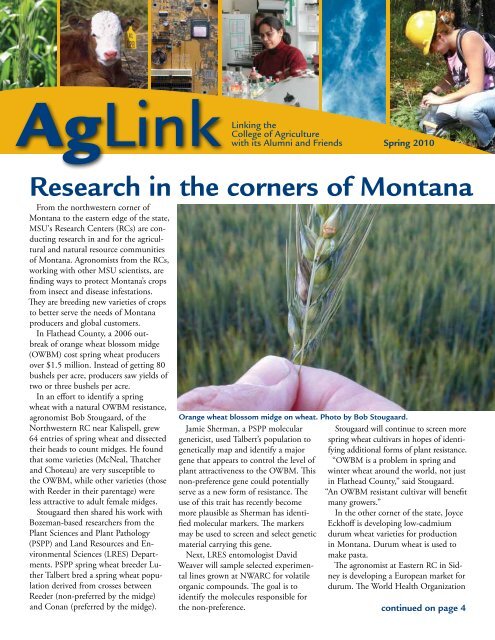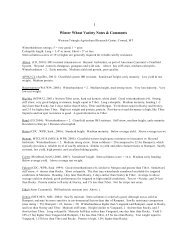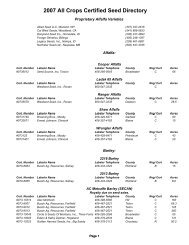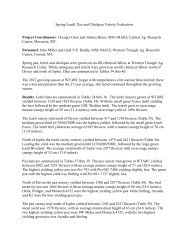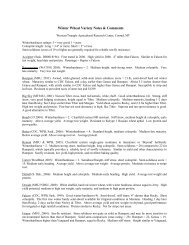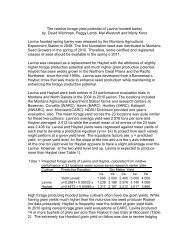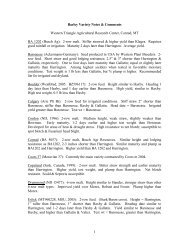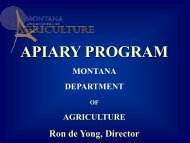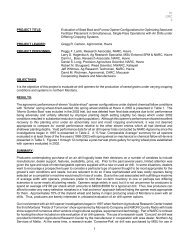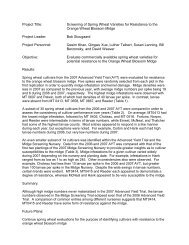Spring 2010 - College of Agriculture - Montana State University
Spring 2010 - College of Agriculture - Montana State University
Spring 2010 - College of Agriculture - Montana State University
You also want an ePaper? Increase the reach of your titles
YUMPU automatically turns print PDFs into web optimized ePapers that Google loves.
AgLink<strong>Spring</strong> 2005Linkingthe<strong>College</strong> <strong>of</strong> <strong>Agriculture</strong>with its Alumni and Friends <strong>Spring</strong> <strong>2010</strong>Research in the corners <strong>of</strong> <strong>Montana</strong>From the northwestern corner <strong>of</strong><strong>Montana</strong> to the eastern edge <strong>of</strong> the state,MSU’s Research Centers (RCs) are conductingresearch in and for the agriculturaland natural resource communities<strong>of</strong> <strong>Montana</strong>. Agronomists from the RCs,working with other MSU scientists, arefinding ways to protect <strong>Montana</strong>’s cropsfrom insect and disease infestations.They are breeding new varieties <strong>of</strong> cropsto better serve the needs <strong>of</strong> <strong>Montana</strong>producers and global customers.In Flathead County, a 2006 outbreak<strong>of</strong> orange wheat blossom midge(OWBM) cost spring wheat producersover $1.5 million. Instead <strong>of</strong> getting 80bushels per acre, producers saw yields <strong>of</strong>two or three bushels per acre.In an effort to identify a springwheat with a natural OWBM resistance,agronomist Bob Stougaard, <strong>of</strong> theNorthwestern RC near Kalispell, grew64 entries <strong>of</strong> spring wheat and dissectedtheir heads to count midges. He foundthat some varieties (McNeal, Thatcherand Choteau) are very susceptible tothe OWBM, while other varieties (thosewith Reeder in their parentage) wereless attractive to adult female midges.Stougaard then shared his work withBozeman-based researchers from thePlant Sciences and Plant Pathology(PSPP) and Land Resources and EnvironmentalSciences (LRES) Departments.PSPP spring wheat breeder LutherTalbert bred a spring wheat populationderived from crosses betweenReeder (non-preferred by the midge)and Conan (preferred by the midge).Orange wheat blossom midge on wheat. Photo by Bob Stougaard.Jamie Sherman, a PSPP molecular Stougaard will continue to screen moregeneticist, used Talbert’s population to spring wheat cultivars in hopes <strong>of</strong> identifyingadditional forms <strong>of</strong> plant resistance.genetically map and identify a majorgene that appears to control the level <strong>of</strong> “OWBM is a problem in spring andplant attractiveness to the OWBM. This winter wheat around the world, not justnon-preference gene could potentially in Flathead County,” said Stougaard.serve as a new form <strong>of</strong> resistance. The “An OWBM resistant cultivar will benefituse <strong>of</strong> this trait has recently become many growers.”more plausible as Sherman has identifiedmolecular markers. The markers Eckh<strong>of</strong>f is developing low-cadmiumIn the other corner <strong>of</strong> the state, Joycemay be used to screen and select genetic durum wheat varieties for productionmaterial carrying this gene.in <strong>Montana</strong>. Durum wheat is used toNext, LRES entomologist David make pasta.Weaver will sample selected experimentallines grown at NWARC for volatile ney is developing a European market forThe agronomist at Eastern RC in Sid-organic compounds. The goal is to durum. The World Health Organizationidentify the molecules responsible forthe non-preference.continued on page 4
CampusWhat Do You See?Most <strong>of</strong> us are blessedwith the ability to see, feel,hear, think, reason andenjoy the richness <strong>of</strong> lifeand its up and down experiences. As one person out <strong>of</strong> 300+million in the United <strong>State</strong>s, the connection between mysenses (if I have any) and my life experiences are unique inone sense, not unique in others. What one does with theseexperiences is what defines us and increases our knowledgeand appreciation for the world. This is particularly truewhen you are in the smallest <strong>of</strong> minorities, individuals withsome interest in, and connection to agriculture.As we come out <strong>of</strong> winter into spring, is there anythingbetter than a favorite wool sweater that took the chill <strong>of</strong>f?Now, as spring comes, it goes into a neatly folded pile <strong>of</strong>other favorites to return in the future clothing mix. I wonderabout the experiences <strong>of</strong> the fiber-producing lamb. Was thiswool from a flock that learned how to graze noxious weeds fortheir sustenance? Did all <strong>of</strong> the siblings make it from birth toshearing? Were they from <strong>Montana</strong>, as indicated by the highquality fiber? There is a richness and lore behind the wool.As I travel throughout <strong>Montana</strong>, there are a lot <strong>of</strong> fencesthat trace the landscape. Are these fences borders from onefamily to the next or barriers that say “keep out?” Theyare a line that says “we are here,” possibly for generationsupon generations. One wonders about the people who builtthe fence, their values, beliefs, toughness, self-sufficiencyand like the fence, what they stand for as people and theirexperience. The fence, like the people that built it, is part<strong>of</strong> a unique element <strong>of</strong> cowboy life with an eye on survival,through thick and thin.Having just finished breakfast, I look at the box <strong>of</strong> cerealand think about how it will fuel me for the next four hours.But occasionally I think a little deeper and imagine thewheat and barley waving in the field. It must survive nothaving enough water at the right time and the attack <strong>of</strong>mother natures’ pests. The farmer and his family make thousands<strong>of</strong> decisions needed to produce this high quality grainand there is a frenzy to harvest it and get it into the bin beforeit is taken away. There is more to that box <strong>of</strong> cereal thanwe will ever know, particularly if we do not wonder.Sometimes I see the surface, sometimes I intuitively gobelow the surface, and sometimes I attempt to connect thecomplexities surrounding life. The wool sweater, the fenceand the cereal box all lend value to agriculture and its experiences,challenges and successes. <strong>Agriculture</strong> is connectedto the core fabric <strong>of</strong> who we are and is one small part <strong>of</strong>the population that makes a difference for the masses. I seesmall miracles every day. What do you see?Jeff JacobsenDean and DirectorAwards for ExcellenceThree <strong>of</strong> MSU’s top <strong>College</strong> <strong>of</strong> <strong>Agriculture</strong>seniors and their mentors were recentlyrecognized during the 28 th annualAwards for Excellence banquet. The MSUAlumni Association and the BozemanArea Chamber <strong>of</strong> Commerce sponsor thebanquet each year. The Awards for Excellenceprogram recognizes students whohave outstanding records <strong>of</strong> achievementin academics, extracurricular activitiesand service to the <strong>University</strong> and theBozeman community. Student nomineesmust have a cumulative grade pointaverage <strong>of</strong> 3.5 or above. These awardsare among the most prestigious honorsbestowed by MSU.Honored students are nominated byfaculty in their college or department.In turn, the award-winning studentseach select mentors who have providedthem with guidance and inspiration.These mentors are honored alongsidethe student achievers.The <strong>2010</strong> <strong>College</strong> <strong>of</strong> <strong>Agriculture</strong> ExcellenceAward honorees are Lauretta Hill <strong>of</strong>Dillon, Alexey Kalinin <strong>of</strong> Bozeman andRhiannon Spaw <strong>of</strong> Bozeman.Hill is an agricultural educationmajor and named Carl Igo, an assistantpr<strong>of</strong>essor in the Division <strong>of</strong> AgriculturalEducation, as her mentor. She is thedaughter <strong>of</strong> Norman and Estelle Hill.Kalinin is a soil and water sciencemajor and named Jill Davis, an adjunctinstructor in English, as his mentor. Heis the son <strong>of</strong> Gary and Elena Turner.Spaw is an environmental horticulturemajor and named Bill Hoch, anPhoto by Megan Walthall.assistant pr<strong>of</strong>essor in the Department<strong>of</strong> Plant Sciences and Plant Pathology,as her mentor. She is the daughter <strong>of</strong>Raymond and Vickie Spaw.Kevin O’Neill, a pr<strong>of</strong>essor in theDepartment <strong>of</strong> Land Resources andEnvironmental Sciences, was also recognizedas a mentor by Nathaniel Julian, asecondary education major.2
Faculty/OutreachEconomics pr<strong>of</strong>essor to retireBob Lee <strong>of</strong> Judith Gap—a longtime rancher who is widelyrecognized for his stewardship <strong>of</strong> the land—will give the <strong>2010</strong>commencement address for the <strong>College</strong> <strong>of</strong> <strong>Agriculture</strong>.The ceremony will be held at 8am Saturday, May 8, in theNorth Gym-PE Complex on the MSU campus. Lee said heplans to talk about the graduates and the future <strong>of</strong> agriculture.His address will both challenge and encourage.“I still believe there’s a lot <strong>of</strong> sizzle in agriculture,” Lee said,“it’s our future.”Lee and his wife, Kathy, own and operate the Robert E.Lee Ranch Co. in the foothills <strong>of</strong> the Snowy Mountains. Heloves what he does and considers it a privilege to care for “ourgreatest renewable resource—grazing land and farmland.”Lee has served in a variety <strong>of</strong> leadership positions from thelocal to national level and has won numerous awards. Amongthem was the national Environmental Stewardship Awardfrom the National Cattlemen’s Beef Association. In <strong>Montana</strong>,he was named Range Man <strong>of</strong> the Year, Soil and Water Conservationist<strong>of</strong> the Year and MSU Agriculturist <strong>of</strong> the Year, toname a few <strong>of</strong> his many honors.Lee acknowledges that agriculture is facing challenges, withone <strong>of</strong> the biggest being communication with consumers.“We all have to step up and address the issues,” he said.Lee didn’t attend MSU, but his three children—Kim,Krista and Kenny—all graduated from MSU with honors inEconomics pr<strong>of</strong>essor Doug Youngbegan teaching at <strong>Montana</strong> <strong>State</strong> <strong>University</strong>in 1977.“I was attracted to MSU by thecombination <strong>of</strong> teaching, research andoutdoor recreational opportunities,”Young said. “More than 30 years later Istill appreciate those things.”Young will be retiring on June 1.About half <strong>of</strong> Young’s research hasinvolved state and local finances. He hasworked on issues such as implications <strong>of</strong>a sales tax on <strong>Montana</strong>, school finance,and teacher salaries. He has worked withpolicy makers on many different levels,including the <strong>Montana</strong> Legislature.His writing has appeared in academicjournals including the NationalTax Journal and Public Finance, andlocal outlets such as <strong>Montana</strong> BusinessQuarterly and <strong>Montana</strong> Policy Review.He was a member <strong>of</strong> the 2002 Gover-Doug Young. Photo by Kelly Gorham.nor’s Income Tax Advisory Council andserved on the Department <strong>of</strong> Revenue’sTax Reform Review Group.“I received a lot <strong>of</strong> satisfaction fromreal-world research,” Young said.Bob Lee to speak at ag commencementYoung has been a visiting pr<strong>of</strong>essor atCarnegie Mellon <strong>University</strong> in Pittsburghand three universities in Africa(the <strong>University</strong> <strong>of</strong> Botswana, Al Akhawayn<strong>University</strong> in Morocco and theAmerican <strong>University</strong> in Egypt). In 2003-04 he was a Fulbright Pr<strong>of</strong>essor at the<strong>University</strong> <strong>of</strong> International Business andEconomics in Beijing, China. In 2009,he was a visiting pr<strong>of</strong>essor at the IndianInstitute <strong>of</strong> Technology in Mumbai.“Those experiences stimulated myinterest and ability to teach our students,”Young said. “They were alsogreat family adventures.”Young plans to teach a few classes atMSU after retirement and looks forwardto being on campus and maintaininghis connection with the university andhis colleagues.the 1990s. Because <strong>of</strong> their involvement and MSU’s strongcommitment to agriculture, Lee said he is an avid supporter<strong>of</strong> the <strong>College</strong> <strong>of</strong> <strong>Agriculture</strong>.“<strong>Agriculture</strong> is our lifeblood,” he said. “<strong>Agriculture</strong> is whatwe do.”Bob Lee. Photo by Kathy Lee.3
DevelopmentWrappin’ it upWith the close <strong>of</strong> another academicyear, MSU’s <strong>College</strong> <strong>of</strong> <strong>Agriculture</strong>will award diplomas to students thathave elected to enrich their lives andincrease their earning power througheducation. As we say goodbye tothese students, we wish them successin their careers. With every graduation,new chapters <strong>of</strong> great storiesbegin. Just as our outstanding alumni before them, <strong>College</strong> <strong>of</strong> <strong>Agriculture</strong>graduates will go on to start businesses, raise families, feedour nation, lead companies and lead governments.As supporters and alumni, you play a big role in the success <strong>of</strong>our graduates. Many <strong>College</strong> <strong>of</strong> <strong>Agriculture</strong> students rely on scholarshipsto finance their education. Often times, without scholarshipsupport, students are forced to delay their education or work hoursthat prolong or jeopardize their studies. Because scholarships areso important to students, the way scholarship endowments aremanaged within the MSU Foundation is critical.As many <strong>of</strong> us are painfully aware, the economic challenges <strong>of</strong>2008 and 2009 were hard on investment portfolios and the investmentpool <strong>of</strong> the MSU Foundation was not immune. While thepool performed better than the Standard and Poor index and those<strong>of</strong> many peer institutions, it declined by nearly 20 percent fromJuly 1, 2008 to June 30, 2009, amounting to a loss <strong>of</strong> $18,349,925.Given these challenges, our generous supporters stepped up. Ourfriends and alumni responded by making gifts that allowed us tomeet scholarship commitments and provide the support necessaryfor our outstanding students to continue making progress towardMSU degrees. This generosity reminded me <strong>of</strong> how lucky we are tobe a part <strong>of</strong> an agriculture community that maintains its commitment,even in lean times.With all <strong>of</strong> the bad news we have had to bear in the last couple <strong>of</strong>years, I am thrilled to report some good news. During the calendaryear 2009, the MSU Foundation’s investments gained 29 percent. Onthe <strong>College</strong> <strong>of</strong> <strong>Agriculture</strong> level, this growth equates to a $75,000increase in the amount <strong>of</strong> scholarship dollars reaching students.This is welcome news and a reason to be optimistic. However, it isthe generosity <strong>of</strong> our supporters that is a true cause for celebration.Even while dealing with personal economic challenges, you stood withus, and that is a shining example <strong>of</strong> how commitment can lead to greataccomplishment. Thank you for your loyalty and encouragement.Corners continued from coverplaces a 0.2 parts per million cadmium limit on durumwheat intended for human consumption. <strong>Montana</strong>durum wheat must meet that limit for export.Durum currently grown in <strong>Montana</strong> can be high incadmium, a nonessential heavy metal that can causehealth problems in some people. Diet is the mainsource <strong>of</strong> cadmium for nonsmokers, with cereal productsaccounting for up to 20 percent <strong>of</strong> daily intake.In <strong>Montana</strong>, cadmium accumulates in the durumgrain and is transferred to wheat-containing productslike pasta.“By chance, varieties <strong>of</strong> durum that grow well in<strong>Montana</strong> have a genetic predisposition to absorb morecadmium.” Eckh<strong>of</strong>f said.Eckh<strong>of</strong>f crossed high quality lines as female parentsand low cadmium accumulation lines as male parents.The progeny were grown in the greenhouse at EARCand the subsequent generation was grown in thefield. Using a genetic marker, these third generationplants were screened for the low cadmium accumulationgene at the USDA-ARS Western Regional SmallGrains Genotyping Laboratory in Pullman, Wash.Eighty-seven lines had the low cadmium accumulationgene. These lines are now growing in the field andwill be evaluated for agronomic and quality characteristics.They will also be used as parent plants tomaintain populations.In the next few years, the low cadmium cultivar will begrown at RCs around the state and evaluated for yield.Tyler WiltgenDirector <strong>of</strong> DevelopmentClass <strong>of</strong> ’05 (BS) Ag Education & ’07 (MS) Applied EconomicsLow cadmium durum in the EARC greenhouse.Photo by Joyce Eckh<strong>of</strong>f.4
ResearchResearchers weighthe risks, benefits <strong>of</strong>spraying mosquitoesEvening maneuvers and a mannequin named“Tyvek Man” are involved in MSU research weighingthe risks and benefits <strong>of</strong> spraying mosquitoes.To conduct their field work, Bob Peterson, associatepr<strong>of</strong>essor <strong>of</strong> entomology, and his studentsdrive a pickup truck across an MSU researchfield and release a cloud <strong>of</strong> insecticide. Then theyreturn to the spot to collect dead mosquitoes andinsecticide droplets that landed on the ground oron Tyvek Man’s white overalls.The researchers take their samples to the lab to determinewhether it’s riskier to use a specific pesticide or not to useit, Peterson said. They look at the pesticide’s effect on theenvironment, and the potential impact on water, soil, animals,and people. They also consider the diseases that could spreadif the pesticide isn’t applied.Peterson and his team conduct their field work during summerevenings when adult female mosquitoes are most likelyto fly. That’s generally July and August in <strong>Montana</strong>, and earlytomid- June in California, where Peterson also conductsexperiments. The scientists focus on adult females, becausethey’re the mosquitoes that bite humans and others. In theMSU bakes a better breadFor undergraduates looking for a parttimejob, the Cereal Quality Laboratory(CQL) might be the place to look.“We hire six to nine students a year,”said CQL manager, Deanna Nash. “It’sgreat for them because they get paidwhile learning lab skills and scientificmethods, but they also learn how tobalance work and school.”The CQL cooperates with MSU’swheat breeders, field technicians,research center scientists, and othersto ensure that high quality wheat isreleased and recommended by the <strong>Montana</strong>Agricultural Experiment Station.Additionally, the CQL assists with thedevelopment <strong>of</strong> new markets for <strong>Montana</strong>wheat and other small grains.“MSU’s wheat breeders are improvingwheat varieties. They grow new plantCollin Preftakes with Tyvek man. Photo by Bob Peterson.crosses all over the state,” said Nash. “Inthe fall, they send the harvest samplesto us to test.”Nash and the CQL staff conduct 17,000analyses for protein and moisture levelson the harvested crosses. This ensures thatStudent working in the Cereal QualityLaboratory. Photo by Kelly Gorham.process <strong>of</strong> obtaining blood to nourish their eggs, some <strong>of</strong> themosquitoes transmit diseases like West Nile Virus.MSU researchers in the Biological Risk Assessment programhave analyzed the benefits and risks <strong>of</strong> pesticides for mosquitoessince 2002, Peterson said. That’s when West Nile Virus becamea major public health concern in western North America.The group has found, so far, that the risks from exposureto mosquito insecticides are among the lowest the group hasestimated or observed. If insecticides are used according tothe product label, the risks will remain well within currentlevels <strong>of</strong> concern.“The risks from West Nile Virus are very real and exceedthe risks from exposure to the mosquito insecticides used tocontrol this public health threat,” Peterson said.<strong>Montana</strong> will maintain its reputation forhigh protein and high quality wheat.Using the CQL’s results, MSU’splant breeders can focus on varietiesthat meet these protein and qualitystandards. Advanced varieties are testedagain at CQL.CQL tests the end products <strong>of</strong> thewheat by milling flour and test bakingbreads. They also evaluate noodles,since some <strong>Montana</strong> wheat is sold tothe Asian noodle market.“Every single test we do matters tosomeone along the line: farmers, elevatoroperators, millers and bakers,” Nash said.The tests matter to the student staff, too.“Most <strong>of</strong> the students start as freshmenand continue working here throughgraduation,” Nash said. “It’s nice toknow they enjoy their time at CQL.”5
StudentsAGED students organize <strong>State</strong> FFA ConventionIn late March, over 1,000 FFA members attendedthe <strong>2010</strong> <strong>State</strong> FFA Convention on the MSU campus.The event was organized and hosted by students in theAGED class, “Agricultural Youth Event Management.”“We give the students some rope and let them run theevent,” said ag education pr<strong>of</strong>essor Marty Frick. “Weare still there to support them, but the students do thelion’s share <strong>of</strong> the work.”The seminar class was established in 1998 for studentswho wanted to get academic credit for organizing the convention.Students plan all aspects <strong>of</strong> the event including therecruitment <strong>of</strong> over 100 judges, managing contests, compilingcontest results and acquiring the appropriate materials.About half <strong>of</strong> ag education students plan to becomehigh school agriculture teachers, while the other half goon to work as extension agents, according to Frick. Ineither career, they will likely put on events similar tothe <strong>State</strong> FFA Convention.Each student in the class is assigned one event tomanage. The head chair <strong>of</strong> the event is elected by theCollegiate FFA organization.“The students practice leadership, organization andcommunication,” said Frick. These are important skillsregardless <strong>of</strong> the career students choose.”MSU students score in top five on range management testAn MSU student and the MSU teamfinished in the top five at the <strong>2010</strong> UndergraduateRange Management Examin Denver.Out <strong>of</strong> 209 students from 24 universities,Kailee Bickford <strong>of</strong> Havre, a seniorMSU students at the Undergraduate RangeManagement Exam in Denver. Photo courtesy <strong>of</strong>Bret Olson.6FFA convention. Photo by Kelly Gorham.in natural resources and rangeland ecology,tied for third place in the individualcategory. She and a student from the<strong>University</strong> <strong>of</strong> Wyoming each earned 220points. The first- and second-place winnerscame from Brigham Young <strong>University</strong>and Colorado <strong>State</strong><strong>University</strong>, respectively.MSU’s team tied forfourth with Texas A & M<strong>University</strong>. Each earned579 points. The top threeteams came from BrighamYoung <strong>University</strong>, the<strong>University</strong> <strong>of</strong> Wyomingand the <strong>University</strong> <strong>of</strong>Alberta, respectively.MSU students who tookthe undergraduate exam,in addition to Bickford,were Daniel Pratt <strong>of</strong> MilesCity, Daisy Garverich <strong>of</strong>Butte, Lynne Buckles <strong>of</strong>Wyola, Schaun Lingohr <strong>of</strong> Malta, JenniferEsp <strong>of</strong> Big Timber, Elizabeth Smith<strong>of</strong> Glen, Ben Lynn <strong>of</strong> Clyde Park, LindsayWilsey <strong>of</strong> Big Timber, Tara Turnbull<strong>of</strong> Brockton, Brandon Hartz <strong>of</strong> GallatinGateway and Jordan Rice <strong>of</strong> SanFrancisco. Ten team members major innatural resources and rangeland ecology,and two major in animal science.Merrita Fraker-Marble, MSU’s coachand a research associate in the Department<strong>of</strong> Animal and Range Sciences,said the two-hour test covered rangeecology, grazing management, range improvements,range regions, range inventoryand analysis, and multiple use. Thestudents also solved problems in grazingmanagement, range improvements, andrange inventory and analysis.In addition to completing the test,Pratt was elected to a one-year term asStudent Conclave President. His termbegan in February.
New MSU President connected to ag<strong>Agriculture</strong> is recognized as an importantfocus <strong>of</strong> land-grant universities like<strong>Montana</strong> <strong>State</strong> <strong>University</strong>. To emphasizethis importance, MSU President WadedCruzado is planning to visit the <strong>Montana</strong>Agricultural Experiment Station’s(MAES) seven research centers acrossthe state in the not-too-distant future.Cruzado, MSU’s 12 th president, saysthe <strong>College</strong> <strong>of</strong> <strong>Agriculture</strong> and MAESare especially important to the people<strong>of</strong> <strong>Montana</strong>.“Our agricultural teaching, researchand outreach programs are focused onmeeting the changing needs <strong>of</strong> <strong>Montana</strong>ns,”Cruzado said. “These programsprovide important knowledge and technologicalsolutions. They improve thequality <strong>of</strong> life <strong>of</strong> thousands <strong>of</strong> citizensacross the state.”Land-grant universities date back tothe middle <strong>of</strong> the Civil War, when thecountry’s leaders decided to create ahigher education system. The MorrillAct—named after Vermont CongressmanJustin Morrill—was signed intolaw in 1862 by President AbrahamLincoln. The Act allowed revenue fromthe sale <strong>of</strong> federal lands to be used forthe establishment <strong>of</strong> universities acrossthe nation.Cruzado has a strong history withland-grant institutions.Prior to coming to MSU, Cruzadowas executive vice president and provostat New Mexico <strong>State</strong> <strong>University</strong> andserved for a year as its interim president.Before that, she was at the <strong>University</strong> <strong>of</strong>Grad student receives fellowshipfrom heart associationSara Wezensky. Photo by Jackson Harris.NewsWaded Cruzado. Photo by Kelly Gorham.Puerto Rico - Mayaguez. Both are landgrantuniversities.Today there are more than 100 institutionsthat are designated as landgrants.MSU was established in 1893 andrecently celebrated its 117 th anniversary.Sara Wezensky, an MSU graduate student working on her Ph.D. in veterinary molecularbiology, has won a two-year fellowship from the American Heart Association.The Pacific Mountain affiliate, pre-doctoral fellowship will allow her to continueresearching the mechanisms <strong>of</strong> drug resistance. She is specifically focusingon the gene srbA and a common mold called Aspergillus fumigatus. Themold can invade the lungs <strong>of</strong> humans and cause dangerous diseases, includingInvasive Pulmonary Aspergillosis. Patients with compromised immune systems,especially organ transplant patients, are particularly at risk. The srbA geneallows molds to thrive during infections, but when the gene is removed, themold becomes much more vulnerable.Wezensky wants to understand how the gene regulates resistance and how itorchestrates the activities <strong>of</strong> other genes.“I’m totally enthralled with my project,” Wezensky said.Wezensky works on basic research that has clinical relevance. Both aspectsappeal to her, she said.“The evolution <strong>of</strong> drug resistance is <strong>of</strong> great interest to me, and this as a topic<strong>of</strong> research has the more immediate potential to be applicable in the clinicalsetting,” she commented.Wezensky earned her undergraduate degree from the <strong>University</strong> <strong>of</strong> Louisvillebefore coming to MSU where she completed her laboratory rotation in the Department<strong>of</strong> Veterinary Molecular Biology (VMB). She joined Robert Cramer’slab in May 2009.Appreciative <strong>of</strong> Cramer and the entire VMB department, one thing thatdrew Wezensky to MSU was the low ratio <strong>of</strong> principal investigators to graduatestudents. “It appeared I wouldn’t get as much hands-on training as I felt Iwould need at other institutions with higher ratios,” she said.7
CalendarSaturday,May 8<strong>College</strong> <strong>of</strong> Ag Commencementceremony 8 a.m. North Gym-PE complex.Main commencement ceremony10 a.m. Brick Breeden Fieldhouse.Field Days <strong>2010</strong>June 17June 17–18June 29July 7July 8July 22July 28August 11Central Ag Research Center, MoccasinMAES Summer Conference, MoccasinNorthern Ag Research Center, HavreSouthern Ag Research Center, HuntleyPost Farm Field Day, BozemanNorthwestern Ag Research Center,CrestonEastern Ag Research Center, SidneyWestern Ag Research Center, CorvallisFor more information,contact Robin or Lisa at 994-3681.Photo by Kelly Gorham.AgLink is published two times yearly by the MSU <strong>College</strong> <strong>of</strong> <strong>Agriculture</strong>. Contributors: Evelyn Boswell, Melynda Harrison and Anne Pettinger Cantrell.Design by MSU Creative Services. For more information, contact us at: MSU <strong>College</strong> <strong>of</strong> <strong>Agriculture</strong> • 202 Linfield Hall • Bozeman, MT 59717tel: 406-994-3681 • fax: 406-994-6579 • e-mail: agdean@montana.edu • web: http://ag.montana.edu<strong>College</strong> <strong>of</strong> <strong>Agriculture</strong><strong>Montana</strong> <strong>State</strong> <strong>University</strong>202 Linfield HallBozeman, MT 59717Non-pr<strong>of</strong>it OrganizationU.S. PostagePAIDPermit No. 69Bozeman, MT 59715Return Service Requested


